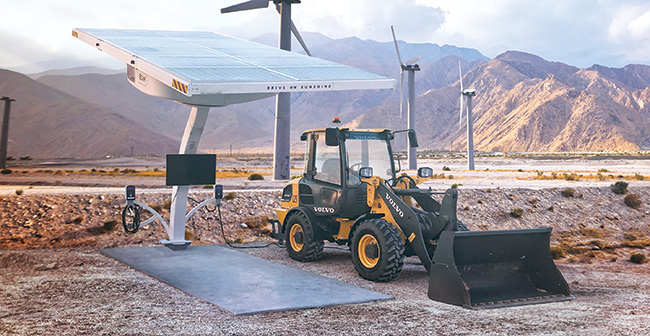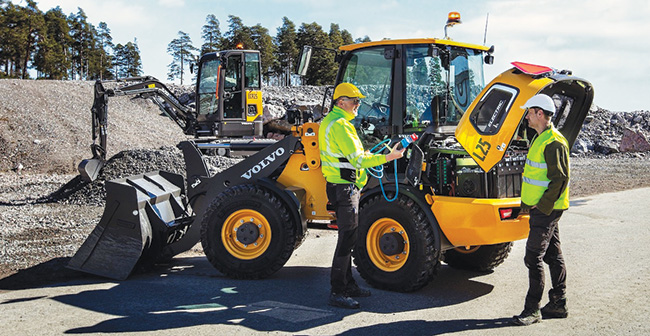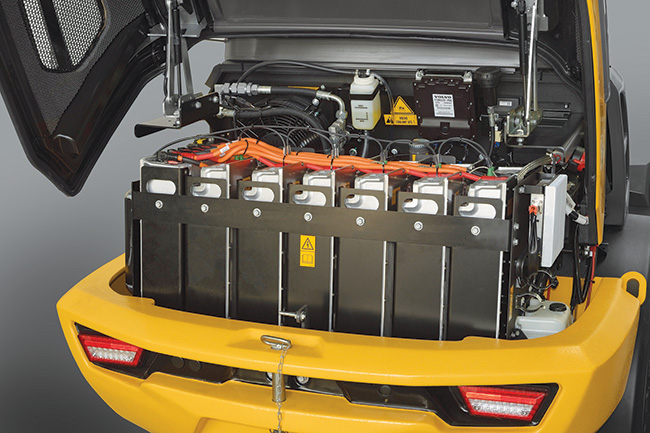How to power up—and cut your daily operating costs—with electric equipment.
By Najing Li
Profit margins in waste and recycling can be razor thin. To lower daily operating expenses and improve margins, some companies are turning to electrically powered heavy equipment to help with sorting, processing, and more.
While the upfront investment can seem steep for this relatively new technology, valuable incentives at the local, state, and federal level can help offset these costs—in some instances, making electric machines comparable in price to diesel models. And when it comes time to power and maintain electric machines to keep them up and running, solutions are expanding too.
Charging with a Common J Plug
It should first be said that charging electric machines is not as cumbersome as you might think. You can charge electric equipment on the same 120-volt outlets found in homes and other buildings, but for optimal charging times we recommend a 240-volt outlet using an SAE J1772 charging adapter, or J plug. If that sounds complicated, do not worry—J plugs are the same kind used to charge electric cars and many other EVs, and they are easy to find. Basically, the more power you can put into your electric machine, the faster it will charge. You can think of it like filling your vehicle with a gas can versus a convenience store fuel pump.
A DC fast charger is another option when you need a quick charge to finish out the day. A DC fast charge solution charges directly with 48V DC and up to 360 amps—and, as a result, charging times are drastically reduced.
So, how fast can these machines be charged? For compact electric machines, charging times can take anywhere from 40 minutes on a DC fast charger up to 24 hours on a common 120-volt household outlet. If you use the recommended 240-volt, Level 2 AC setup, you can expect charge times in the three- to six-hour range.

What About Runtimes?
Now that we have covered charge times, you may be wondering how long a fully charged machine will run. This typically depends on the machine—for many compact electric models, it is likely somewhere in the four- to six-hour range. I am giving a range here because these machines can run very hard, or they can operate in light applications. How hard they are used will impact how long a full charge of the traction batteries will last.
Remember, electric machines shut off automatically when not in use, so they do not rack up idle hours like a diesel machine that needs to keep fuel and fluids moving. Estimated hour usage for electric machines is typically much lower than for comparable diesel models, so machines that can run four to six hours are likely viable options for a full day’s work in typical applications.
The Way You Charge Can Extend Battery Life
If you plan to invest in electric, how you charge can extend how long the batteries perform, so it is important to implement a good charging strategy. The best for battery life is AC Level 2 charging, which is slow charging, versus DC fast charging—but again, it is all about your needs. It is not killing the battery; it is just that you can extend the life of the battery with slower charging.
Another thing to keep in mind is that the lithium-ion technology used in today’s batteries is superior to the old lead-acid or nickel-cadmium technology we sometimes think of with electric vehicles. The best batteries on the market will be maintenance-free and allow for fast charging. Long term, we do not yet know the full lifespan of batteries in electric equipment because the technology is fairly new.

More on Electric Equipment Maintenance
How different is it to maintain electric equipment versus diesel equipment? The short answer is that with electric, it is much simpler—hardly any maintenance is needed at all on the electric components.
DEF and filters are not needed because the engine has been replaced by an electric motor and battery. Essentially, the only supplies required are grease and hydraulic oil. This is much different than a conventional machine that requires fluid, filter, and component checks as often as every day, with additional cyclical preventive fluid and filter maintenance.
The electrical components are sealed and guarded, so technicians should be trained to properly disconnect the high-voltage power to any parts before they are removed and replaced. For example, Volvo CE has stringent training and qualification requirements to certify technicians to work on electric machines, whether it be the electrical or non-electrical components.

A Final Thought
While electric is relatively new in waste and recycling, it is becoming more common. Electric machines are viable alternatives to complement a diesel fleet, and they can help companies significantly reduce daily operating expenses.
It is important to first consider how electric compact equipment might be used in your particular operation, then work with your equipment dealer to understand more about their power and performance. In the near future, larger electric machines (in the 20-ton and up range) will come to market and expand the electric footprint in fleets. They may even replace larger diesel models to cut back on operating expenses further. It is exciting technology to keep an eye on. | WA
Najing Li is Product Manager, Sustainable Power, for Volvo Construction Equipment. She is trained in chemical engineering and has worked for CATL—the world’s largest battery manufacturer—as a battery development engineer and for Audi as their battery development lead. She joined Volvo in 2022 with a focus on electromobility. Najing can be reached at [email protected].
